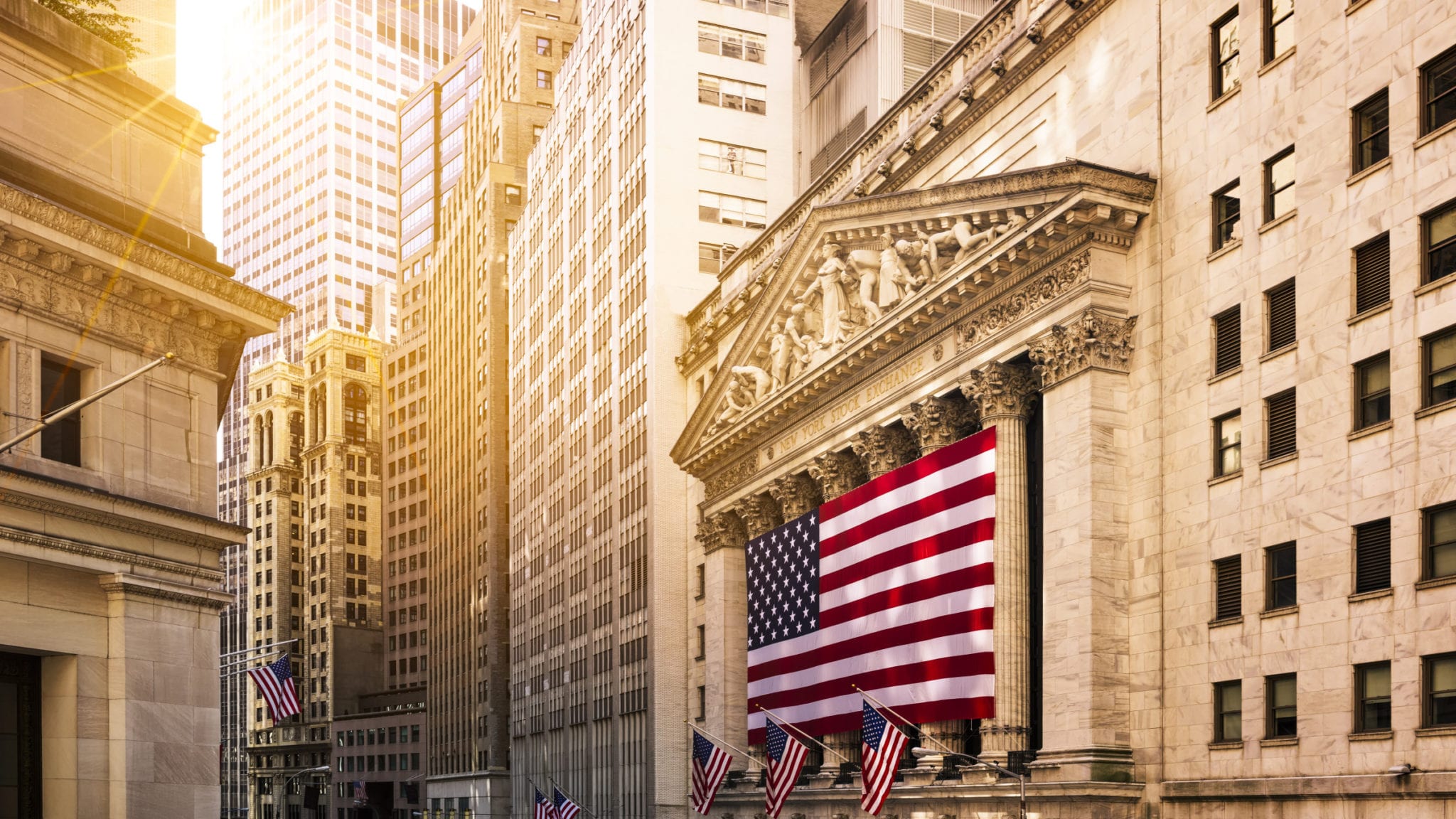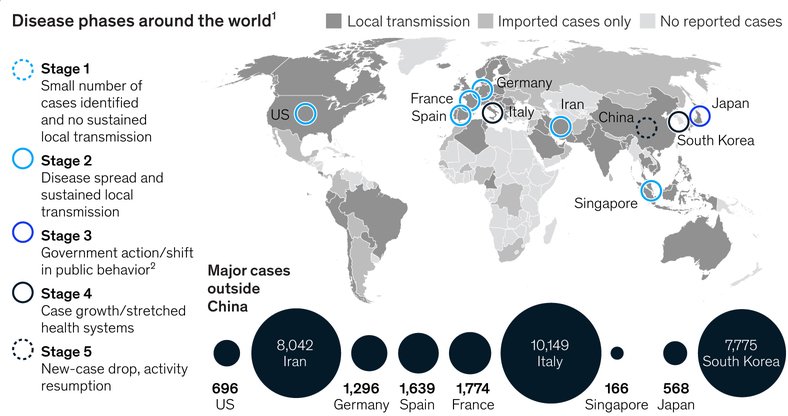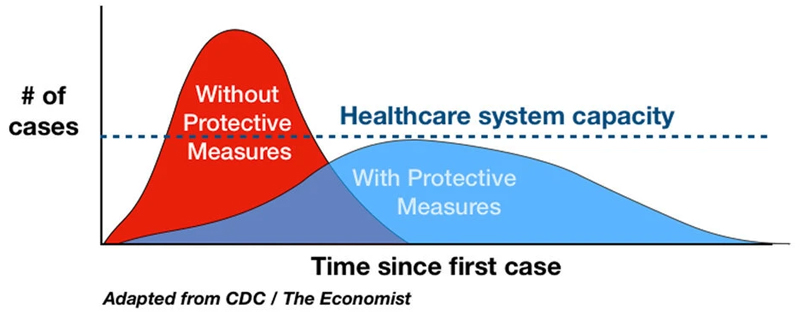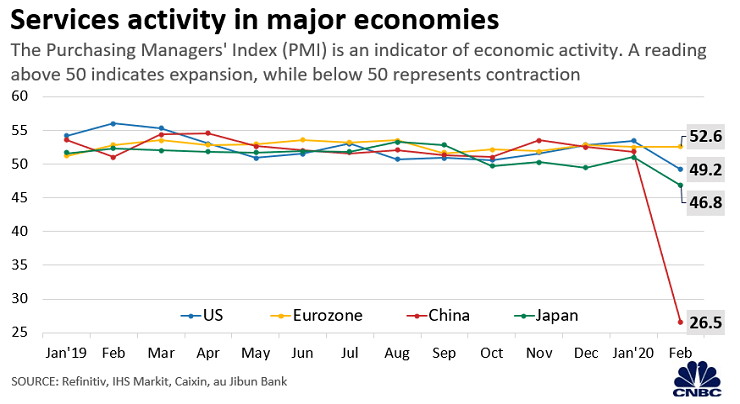Market Pulse
The stock market zoo has a new addition.
The Bulls and Bears have been joined by a small denizen of the animal kingdom, the innocuous-looking Pangolin, which is being pointed to as the source of the Covid-19 virus strain that jumped to humans in the bustling wild-life trade market of Wuhan, China. Since the Pangolin scales won't provide the armor to shield from the virus, the investor breed is now left with the task of not only surviving the brutal market but also the insidious virus.
The viral outbreak has forced the market to price a recession, and it is doing that in just two weeks thus creating a very volatile market where daily 3% to 5% moves are becoming the norm.
Why the US May Be Less Prepared
The viral outbreak is now a pandemic. The outbreak has to be fought on a war-footing. The administration appears to be deflecting this reality based on the limited sense of urgency being conveyed to the population. A realistic scenario needs to be conveyed where a growing percentage of the population is at risk with every passing day. Declaring an emergency would allow FEMA to participate, and unlock significant resources, funding, and crisis expertise, to support states and communities to fight-back.
To curb a novel viral epidemic that is spreading fast requires harsh measures. What is vital is to slow down the cycle of community spread. If we are unable to rein-in the sustained local transmission, the healthcare system runs the risk of simply collapsing as it is overwhelmed.
It appears China was able to finally achieve some stability after harsh measures like quarantining cities. Those harsh measures were resorted to after the country and its policy of managing down any negative news allowed the virus to spread unchecked. Italy is another case where first the northern region and now the entire country is going through a lockdown mode after it allowed the virus outbreak to achieve a critical mass.
If any lessons can be drawn, the first weeks are critical in disrupting a viral spread, after which harsher measures become inevitable. We have to learn from China's mistakes.
McKinsey, the management consulting firm, has identified five stages of the outbreak and the US is beginning to go through Stage 2, which is sustained local transmission.
Why Is Containment The Only Viable Strategy
In the absence of any immunity and targeted therapies, the only way to manage the epidemic is through making sure the healthcare system continues to work. If the hospital system itself becomes overwhelmed with patients and understaffing, as its healthcare workers fall sick, the patients will not receive the care.
The above graphic from a CDC article on pandemic preparation and adapted by The Economist, shows the difference between a viral containment curve and a viral curve that is allowed to march on without effective containment. These 2 epidemic curves underscore the importance of emergency actions to create social distancing. Containment efforts flatten the curve by disrupting the viral spread which reduces the number of hosts or new infections. This decelerates or slows-down the viral outbreak.
The graphic above becomes even more compelling when marked with the healthcare capacity, as shown in the exhibit below.
The above dotted-line visualization was added by Dr. Drew Harris, a population health analyst at Thomas Jefferson University in Philadelphia. Although it's not an exact calculation of the capacity, it makes the point very clearly about what's at stake. Containment is critical for it allows the flattening of the new infection curve, thus giving the healthcare capacity a fighting chance to attend to the sick instead of being overwhelmed by the patient surge.
Containment is not a cure. But such mitigation efforts are vital to decelerating the rate of new infections and allowing the finite capacity at the hospitals to be available to sick people.
Things Are Moving In The Right Direction
While the administration has operated slowly thus far, over-managing the news and underemphasizing its emergency nature, the state governments and businesses are not dithering anymore. New York has ordered a containment area in New Rochelle which has experienced a significant cluster of COVID-19 infection. Very importantly, cities are beginning to ban gatherings above 1,000 people, a prerequisite to avoiding harsher measures down the road.
Businesses are proactively canceling meetings, conferences, and larger gatherings. Universities are extending spring breaks, moving classes online, and asking students to leave campus. Schools are closing down. This is the containment that creates hardships but should prove critical in decelerating the viral outbreak by breaking the chain of sustained local transmission. And it will make a difference.
Stock Market Slide
The stock market has been reeling, and it may remain volatile for at least a couple of weeks more until it starts seeing some improvement in the new infection rate. The market also requires federal government intervention in the form of a forceful stimulus package that will be aimed at businesses and consumers, as well as Federal Reserve intervention in the form of new facilities to ease borrowing and strengthen liquidity, as we also discussed in the article Healthcare Faces A Contagion.
A prudent way for an investor to fight this viral crisis is to be defensive. Reducing market exposure and raising cash levels is a defensive measure. In a recent missive to subscribers from chieftain David Jackson, Seeking Alpha founder, the headline was abundantly clear, "shield your portfolio." This is sagacious advice. In times of heightened uncertainty, the emphasis has to be on capital preservation.
The first-half earnings have been disrupted. To learn about the path that economic activity can follow, China offers some early insights as it's the first severely-hit country where the viral outbreak has plateaued out ~40-days later. Consumer spending and business activity plunged in the first 40 days. Economic activity there is now beginning to pick up, particularly at larger companies, and is estimated to be much stronger by the end of the first quarter, as shown in the graphic below. By then it will be ~75-days from the time the outbreak intensified to the point where much of the economic activity is expected to resume.
One would logically believe that the US should hopefully be able to improve on the timetable for China's recovery as it received a much earlier warning which has allowed us to be better prepared. But we run the risk of losing that advantage to the optics battle, and consequently can make this worse than it already is.
Assuming the administration attacks this viral outbreak on a war-footing, the US economy should begin to get into a recovery mode by early April, which would be a 45-day cycle from the time when the outbreak picked up pace in late February, and much quicker than the 75 days for China. We would not consider this to be an aggressive timeline and one just needs to look at the experience of South Korea which has been able to achieve near plateauing out of the infections so far this week.
In the meantime, consumer and business spending should be adversely affected as they were in China. The graphic below shows the purchasing manager's index for the services sector.
The sharp Chinese drop-off in the activity stands out. The rest of the major economic blocs would be looking at a drop-off as well, though most likely not so steep due to more preparation time.
The US will face a material economic slowdown in the second quarter. One would expect the slowdown though to be a short-term event, limited to the first half. Lower interest rates and lower oil prices will aid the recovery.
Since the disease is sweeping across the globe and through countries that do not have the resources and infrastructure to handle such outbreaks, global trade will remain depressed through the second quarter.
Of course, it's very uncertain what path the outbreak will take in the US and these are just informed estimates. The biggest risk is that the virus becomes resurgent in the second outbreak in China, for that would suggest the rest-of-the-world will witness the same.
Interestingly, the Chinese stock market as represented by the Shanghai Composite Index has shrugged off near-term concerns and is outperforming the US and European indexes. It's a hopeful data point to keep in mind. Furthermore, if our observations are correct, the new infection rate in South Korea, the fourth-hardest hit country, has begun to plateau out after aggressive containment measures.
Conclusion
This is a national emergency and until it's recognized and acted upon as such by the government, we run the risk of inviting more trouble - in the financial markets, economy, and the health of the people. For many Americans, particularly the elderly, it can be a question of life and death. It's in times of crises, like pandemics and wars, that we need the leadership of the government to keep the citizens safe.
There's also the hopeful possibility that approaching this viral epidemic urgently can possibly lead to optimistic outcomes that have not been visible yet, for no other nation can marshal resources in a manner the US can. Good things when they start happening can acquire their own momentum.
Investors have to be patient. This is most likely a short-term setback. A positive sign to look forward to now would be the scope and timing of the fiscal stimulus. Thereafter, the rate of new infections will be a vital statistic to track. Little is known about the potential path and impact of the viral outbreak in the US. Things can turn out better than expected. But we won't know that for another two to three weeks.
This discussion has been informed by a variety of articles including the following in The Economist, CNN, The New York Times, McKinsey, and the CDC.
The article was first submitted for publication on Seeking Alpha on Mar 11, 2020






